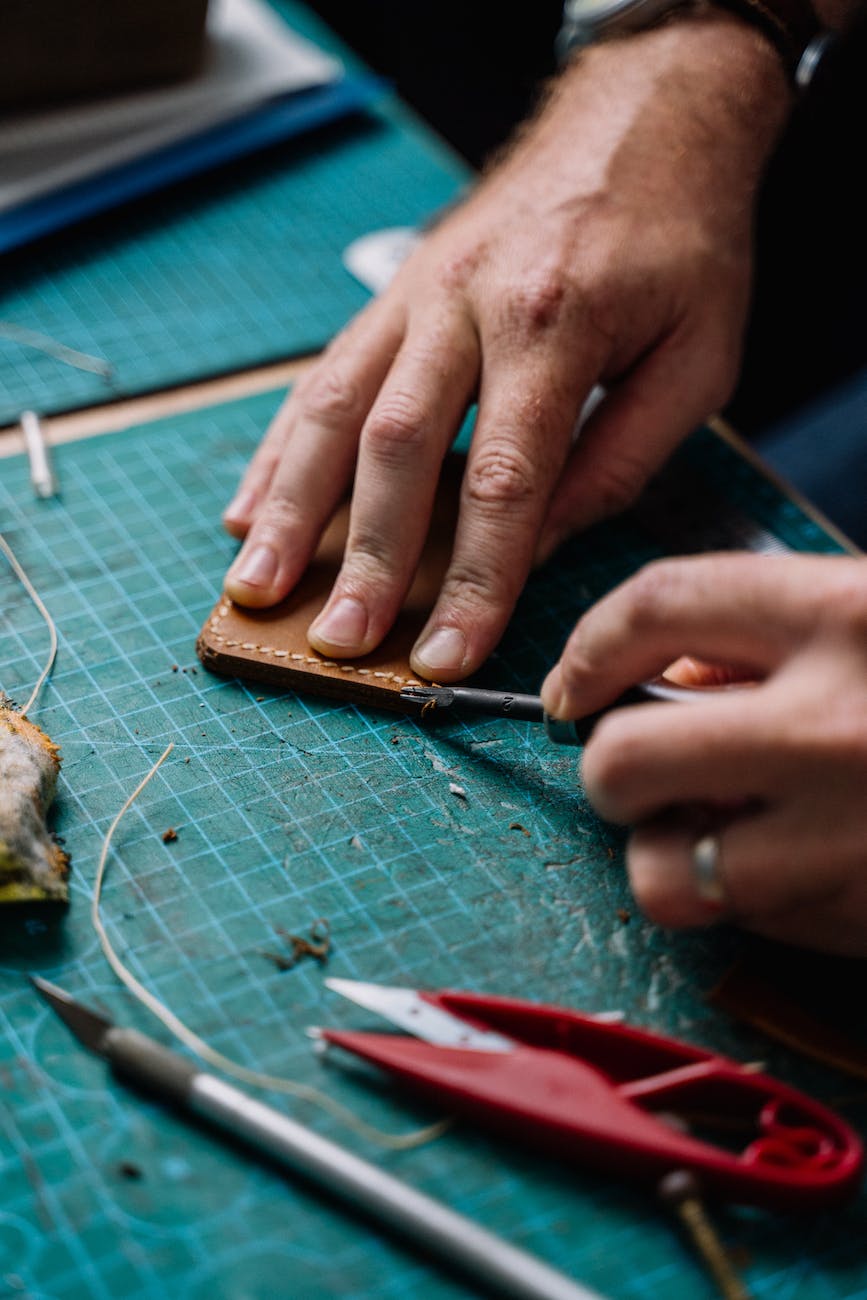The Science of Leatherworking: Understanding Techniques and Leather Types
Chemistry of Tanning and Leather Production
Tanning through mineral, oil, or vegetal processes permanently alters protein structures within hides to create stable non-putrefying leather resistant to temperature, moisture, and decay. Understanding chemistry aids working characteristics.
Tannins bind to collagen proteins, crosslinking them for enhanced durability and thermal stability. Mineral salts like chromium sulfate tan through ion exchange. Oils penetrate skin fully when emulsified. Aldehyde tanning employs polymers.
Knowing leather tanning methods helps predict resulting properties like breathability, softness, pliability, and finishing behaviors. The chemical foundation impacts the entire crafting journey.
Diagnosing Defects – Scars, Brands and Imperfections
Hides exhibit natural imperfections that affect leather quality. Identifying flaws helps avoid disappointment selecting hides for specific uses where certain defects cause functional or aesthetic issues.
Brand marks scar and indent leather with markings that never disappear. Parasitic holes resist stamping over. Neck wrinkles distort shaping. Fat wrinkles cause weak spots. Warbles scar unevenly. Loose grain causes accelerated wear.
For fine decorative work, flawless premium hides excel. For sturdy gear and shoe leather, slight defects get more tolerable if placement avoids high stress zones. Understanding imperfections aids realistic expectations.
The Physics of Adhesives and Stitching
Bonding leather permanently or temporarily relies on adhesive chemistry basics. Stitching leather stresses physics principles too. Insight aids appropriate application.
Adhesives operate through mechanical, dispersive, or cohesive forces chemically linking surfaces. Some bond instantly while others cure over time depending on polymer properties. Temperature, pressure, and porosity impact adhesion strength.
Stitching distributes stress loads through friction and crimping created putting threaded stitch holes under tension. The physics of force distribution prevent tearing with reinforcement using the right spacing, angles and crisscross lacing.
Sharpening Techniques Based on Blade Metallurgy
Achieving razor leather cutting edges depends on understanding blade steel hardness, brittleness, friction, and how honing refines microscopic serrations through abrasion removal and realignment. Science sharpens.
Harder steel holds a keen edge but proves brittle. Alloy blends aim for ideal toughness, strength and corrosion resistance combined. Coatings reduce drag. Grain size affects points. Whetting shaves away crumpled metal through sliding micro-abrasion leaving pristine contours.
Through meticulous technique, leatherworkers polish blades atomically smooth. Steels cut only when sharpened precisely within metallurgical principles through physics converted to art.
Dye Chemistry and Interactions with Leather
Dyeing leather relies on bonding pigment molecules within collagen fibers through chemical interactions so hues remain colorfast permanently. Understanding dye properties and leather reactivity helps perfection.
Reactive dyes bind to proteins covalently through ionic and hydrogen bonding. Some pigments require a metallized mordant. Penetration depth depends on particle size and application viscosity. Thermodynamics affect dye curing and bleed resistance.
Leather’s receptive surface makes an ideal canvas when artfully colored by comprehending the chemical dance between organic leather structure and compatible stable dyes applied under ideal conditions for premium lightfast results.
Thermodynamics of Leather Shaping and Forming
The fundamentals of heat, moisture and pressure get leveraged when forming leather into 3D shapes through deliberate molding and bonding assisted by science and technique.
Heating leather softens and swells fibers allowing manipulation into new forms. Controlled drying sets shapes. Hydration and temperature levels require strict modulation to avoid deterioration through understanding thermodynamics.
With the right amount of strategic tension, compression, steam and restraint, almost impossibly intricate leather geometries take shape guided by competent hands simply nudging nature’s innate tendencies.
Allowing for the Quirks of Organic Materials
Leather’s natural origins mean certain aspects remain pleasantly imperfect in ways industrial materials are not. Accommodating organics’ quirks allows their best characteristics to shine through.
Hide thickness, stretch, and hair follicle density can vary slightly. Natural markings and scars contribute character not flaws. Unique grain patterns and creases sign artisanal origins. Minor asymmetry adds allure.
Perfection is redefined as leather’s meaningful flaws that mark the animal’s life. Their traces hint creature comfort we can appreciate through sensitivity to organic echoes in leathercraft’s foundations.
Preventing Microbial Deterioration
Raw hides getting infected with bacteria or fungi creates major defects and health hazards. Controlling microbial growth requires vigilant methods to avoid spoilage throughout processes.
Each production stage demands cleanliness – from skinning, to tanning, to finishing. Salt, cold, and low moisture impede germs. Tanning also kills pathogens through pH shifts. Storage preservatives inhibit contamination between steps.
Quality assurance and worker safety hinge on preventing microbial leather decay. With proper protocols in facilities, traditional techniques carry forward without risk when procedures align with modern science.
Maximizing Durability Through Engineering Principles
Leatherwork design applying engineering tenets like structural reinforcement, tension distribution, wear minimization, and ergonomics achieves longevity and performance with physics on its side.
Strategic design considers load stresses and friction wear. Angled stitching improves structure. Thicker leather on high grab zones reduces erosion. Rounded edges prevent cracks. Textured grip lowers slippage. Hardware weight balances carry dynamics.
Leather endures elegantly thanks to artisans fusing usability principles with precision craft technique. The marriage grants their functional sculptures both strength and soul.
Whether selecting quality hides or executing precise stamped tooling, the science undergirding leatherworking empowers artisans to elevate durability into beauty. Knowledge of production methods, material behaviors, and physics fundamentals allows timeless mastery refined through each generation practicing their applied chemistry, engineering and design thoughtfully by hand.
